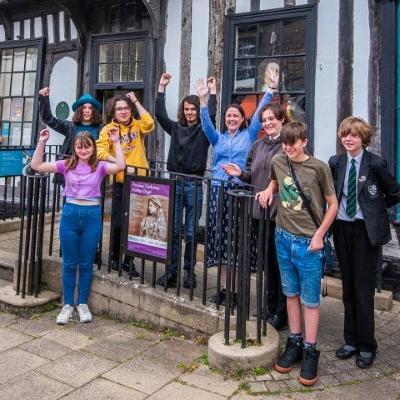THC Youth Group
Every Friday during term time, 4-6pm. Hosted at Ancient House Museum, Thetford. For ages 12 to 25.

Explore history and museum related activities such as filmmaking, curating and costumed events.
Projects are decided by the group - in the past, we have created a First World War Murder Mystery, an exhibition exploring LGBTQ+ history and an escape room.
How to join
Email kickthedust@norfolk.gov.uk to join the group or to find out more about Kick the Dust.
Queering the Vikings
The THC Youth Group led on the interpretation of a display of grave burial goods found at Santon in Norfolk. They were on loan from the British Museum. Discovered were two brooches and a sword with only one skeleton. Previous historians had maintained that this must be evidence of a joint burial of a male and a female Viking. This is because of the traditional gender roles assigned to these objects. The young people drew on the latest research and the expertise of museum colleagues. They developed a new approach to the interpretation of these objects. They used an illustration of a non-binary figure to question the gender assumptions of the past.
We presented our project at Queer Heritage and Collections Network Symposium 2023. Held at the University of Leicester. The Queer Heritage and Collections Network is founded by:
- Research Centre for Museum and Galleries (part of the School of Museum Studies at the University of Leicester)
- National Trust, English Heritage
- Historic England
- Historic Royal Palaces
Queer Heritage and Collections Network is a UK-wide subject specialist network. It supports and develops work with LGBTQ+ collections and histories.
Matthew Storey, curator from Historic Royal Palaces said:
"The teenagers work "set the standard of good practise for the sector."
Richard Sandell, Professor in the School of Museum Studies at the University of Leicester and co-director of the Research Centre for Museums and Galleries, tweeted:
"Absolutely nailed it. Bold, ground-breaking, deeply thought through - massive thanks to the Teenage History Club for sharing their work at #QHCN22"
One of the delegates commented: "Was absolutely blown away by the work by this group of young people!! Give them our jobs!"
Why we use queer
We recognise that some people are uncomfortable with using the word queer, so we'll explain why we decided to use it:
- It is powerful to reclaim a term once used in a derogatory manner and make it a term of pride
- It is an inclusive term for all members of the LGBTQI+ community and avoids the need for a long acronym such as LGBTQQIAAP, which still excludes some
- It recognises the fluid nature of sexuality and gender identity
- It enables those who are questioning or exploring their sexuality to do so without feeling confined or the need to label themselves prematurely
- It is non-binary - it can be applied equally to all genders
- It is a unifying term for the whole community
Follow Kick the Dust
Supported using public funding by Arts Council England













